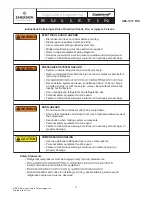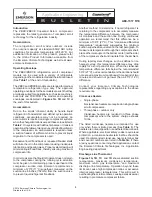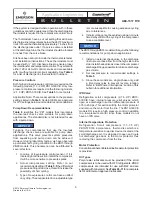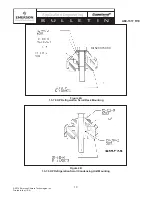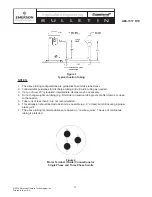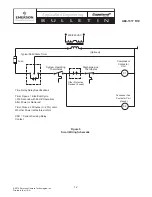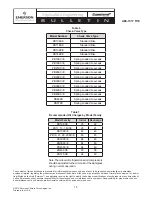
4
© 2014 Emerson Climate Technologies, Inc.
Printed in the U.S.A.
AE4-1317 R10
Application Engineering
B
U
L
L
E
T
I
N
Introduction
The ZBKC/ZBKCE Copeland Scroll
™
compressor
represents the latest generation of compliant scroll
technology for the refrigeration industry.
Nomenclature
The refrigeration scroll model numbers include
the nominal capacity at standard 60HZ ARI rating
conditions for medium temperature (20/120°F). For
additional information on this product, please refer
to the Online Product Information accessible from
the Emerson Climate Technologies web site at www.
emersonclimate.com.
Operating Envelope
The ZBKC/ZBKCE refrigeration scroll compressor
models can be used with a variety of refrigerants
depending on the model selected and the lubricant used.
(See
Table 1
at the end of this bulletin
.
)
The ZBKC and ZBKCE models are intended for medium
temperature refrigeration type duty. The approved
operating envelopes for these models are such that they
are ideally suited for applications such as ice machines,
bulk milk and FCB/FUB. The models and operating
envelopes are depicted in
Figures 1A, 1B
and
1C
at
the end of this bulletin.
Accumulators
Due to the scrolls’ inherent ability to handle liquid
refrigerant in
fl
ooded start and defrost cycle operation
conditions, accumulators may not be required. An
accumulator is required on single compressor systems
when the charge limitations exceed those values listed in
Table 2
. On systems with defrost schemes or transient
operations that allow prolonged uncontrolled liquid return
to the compressor, an accumulator is required unless
a suction header of suf
fi
cient volume to prevent liquid
migration to the compressor is used.
Excessive liquid
fl
ood back or repeated
fl
ooded starts
will dilute the oil in the compressor causing inadequate
lubrication and bearing wear. Proper system design will
minimize liquid
fl
ood back, thereby ensuring maximum
compressor life.
In order to assure that liquid refrigerant does not return
to the compressor during the running cycle, attention
must be given to maintaining proper superheat at the
compressor suction inlet. Emerson recommends a
minimum of 20°F (11°C) superheat, measured on the
suction line 6 inches (152mm) from the suction valve,
to prevent liquid refrigerant
fl
oodback.
Another method to determine if liquid refrigerant is
returning to the compressor is to accurately measure
the temperature difference between the compressor
oil crankcase and the suction line. During continuous
operation we recommend that this difference be a
minimum of 50°F (27°C). This “crankcase differential
temperature” requirement supersedes the minimum
suction superheat requirement in the last paragraph. To
measure oil temperature through the compressor shell,
place a thermocouple on the bottom center (not the side)
of the compressor shell and insulate from the ambient.
During rapid system changes, such as defrost or ice
harvest cycles, this temperature difference may drop
rapidly for a short period of time. When the crankcase
temperature difference falls below the recommended
50°F (27°C), our recommendation is the duration should
not exceed a maximum (continuous) time period of two
minutes and should not go lower than a 25°F (14°C)
difference.
Contact your Emerson Climate Technologies
representative regarding any exceptions to the above
requirements.
Crankcase Heaters
• Single-phase
No crankcase heaters are required on single-phase
scroll compressors.
• Three-phase – outdoor only
Crankcase heaters are required on three phase
compressors where the system charge exceeds
10 lbs.
The listed crankcase heaters are intended for use
only when there is limited access (See
Table 3
). The
heaters are not equipped for use with electrical conduit.
Where applicable, electrical safety codes require lead
protection, a crankcase heater terminal box should be
used. Recommended crankcase heater terminal box
and cover kit numbers are listed in
Table 3A
. If there
are any questions concerning their application, contact
the Emerson Climate Technologies, Inc. Application
Engineering department.
Discharge Line Thermostat
Figures 1A, 1B
,
1C
and
1D
show saturated suction
temperature, maximum condensing temperature,
maximum return gas temperature, and maximum
discharge line temperature. Operation beyond these
limits can cause high compression ratios or excessive
internal compressor temperatures. This will result in
overheating the scroll members, causing excessive wear
resulting in premature compressor failure.



